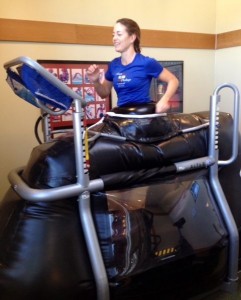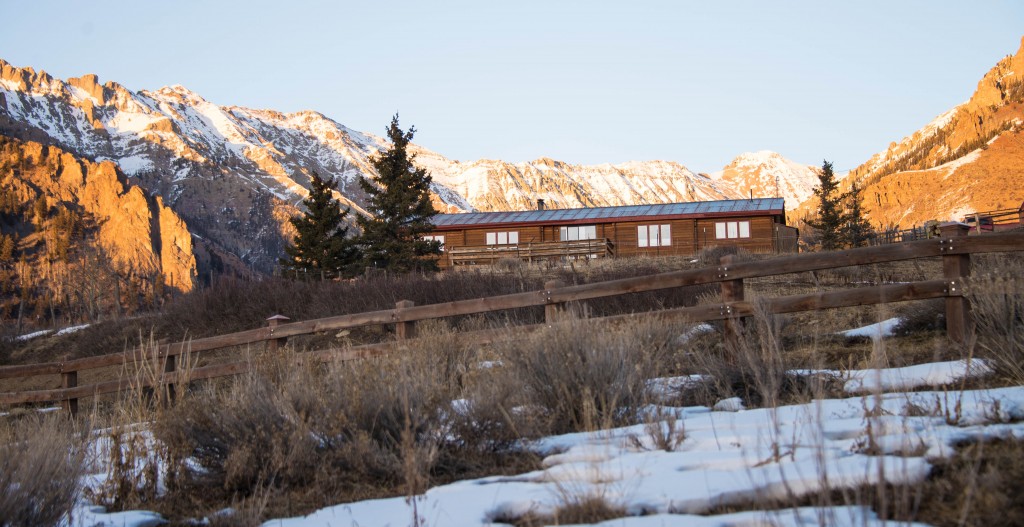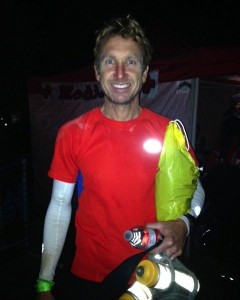The fog feels like it’s lifting. All through November and December, I felt mentally clouded, short-tempered and weepy. My poor family walked on eggshells around me.
The injuries stopped me mid-run on October 25, the ball of my foot throbbing and the third metatarsal stress fracture feeling like I was stepping on a nail. In November, I hobbled around in a Velcro cast and felt virtually no improvement, until December, when I finally could walk almost normally. I could shift my weight onto my bad foot and rise up on tippy toes, but I was still a long way from being able to hop on one foot (my unscientific test for knowing when it’s OK to start running again).
Then, as detailed in the last post, my dog unexpectedly got sick and died in December. I can’t adequately articulate how hard that loss hit and how much I long to have that dog back in my life. It’s been over a month, and I still acutely miss him.
But, for the first time since … since I’m not sure when, probably since last spring, before a series of injuries sabotaged my ability to train and enjoy running … I am feeling cautiously optimistic about reclaiming the ability to run on a regular basis, keeping pain and injury in check.
Only runners who’ve been through an extended period off can understand how out of sorts you feel when you can’t run. You miss the thing that regulates your body clock, unleashes your best thoughts and restores your confidence. You disconnect from running buddies. You put “the runner” part of your identity on a shelf, so you feel insecure and introverted. You begin to lose faith you’ll ever run again.
The day after our dog died, December 19, I drove to the Sequoia Bayview Trail in the Oakland Hills to tentatively try a mile. I needed the catharsis and comfort of running on that familiar trail, but I couldn’t do it—my foot felt weak and radiated twinges of discomfort, so I gave up after 4 minutes and cried. If I had to graph it, that’d be the low point.
Then we went to Telluride a week later for Christmas, to be with extended family. The dirt road next to our family cabin worked its magic. Since my foot finally felt good enough for hiking, I tried a slow jog for a few minutes, then 10 whole minutes. Looking at the snow-streaked mesas dotted with aspen groves, and the majestic peaks of Wilson and Sunshine, I felt hopeful again. During that week, I worked up to four miles, alternately jogging 10 minutes, walking 10.
Here are some photos my daughter took of this special place where I spent a lot of my childhood, where my brother and sister-in-law live, and where I love to visit and run:
In January, I officially got back to running—just a few miles on non-consecutive days—and this past week I worked up to a solid seven miles (whoo-hoo!) on one day and a weekly total of 25.
I’m going to list what I’ve learned—or, re-learned—about coming back and managing injury, not only to share advice that I hope will help others, but also to remind myself of these lessons that are so easy to forget if I become fixated on mileage totals and times.
Keep the faith. In late December, Meghan Hicks wrote to me words that were precisely what I needed to hear and am so grateful for. She wrote, “Keep your head high. You will run again. … Think of determined people like Bev Anderson-Abbs who had a major knee issue and had years of treatments and rehabilitation and limited running, but she persevered and is back at it and running about as well as she did before the issue. And think about Ann Trason and all of her body problems and now she’s running 100-milers healthy again. And, I was injured for over a year, and the rehab process took over a year. But I was stubborn too and did all the rehab, spent the money on treatments, kept after it until I was healthy again. I know your circumstance is unique, but I hope you can find the faith that your body will restore itself.”
Be as serious about your recovery as you are about your training. As Meghan writes above, do all the rehab and spend money on treatments. I bought a pricey ultrasound bone stimulator (thankfully, insurance covered most of it) that I believe speeded up the stress fracture healing. I also worked with a podiatrist to help fix flawed biomechanics.
Use the time you’re not running to do whatever cross training you can and to tackle projects that make you feel better (for me, this meant cleaning out closets). I did strength training and discovered spinning, and I’m committed to continuing a spin class two mornings a week. I also forced myself back into the pool. I still don’t like swimming laps or “pool running,” but it feels therapeutic for my muscles and joints, so I’ll try to swim post-run a couple of times a week, if only for 20 minutes to cool off muscles.
Return to running with patience and low expectations. Don’t even think of the first phase of running again as “running,” but rather, as the next phase in physical therapy and rehab. You’ll likely feel more frustrated than satisfied from the 10-minute jog/walk intervals, or, as Western States champ Ellie Greenwood calls it, “bumbling-along mileage.” She wrote a great article on patience and recovery that I recommend to anyone in the process of restarting running after injury.
Run on an Alter G treadmill if you have access to one. My husband’s Christmas present to me was a gift certificate to use the Alter G at a local PT facility. These “anti-gravity” treadmills create a bubble of air from the waist down that suspends you above the treadmill, and then you can adjust the percentage of body weight that hits the treadmill. By running at 70 to 90 percent body weight, I was able to reap the cardio benefits and get my body used to running again, but with significantly less stress on my feet.
Gauge the pain and stop before it hurts. It’s normal for an injured area to feel “off” or “weak” when you restart, so it’s hard to know if and when to “stop when it hurts,” since the pain does not turn “on” or “off” but rather manifests itself along a spectrum of intensity. I find it helps to think of pain on scale from 1 – 10, where 1 is nonexistent and 10 is absolutely intolerable. I have vowed to make myself stop when it crosses over from “talking to me” (a 2 to 3 on the scale) to aching and uncomfortable (a 4 or higher). In hindsight, I realize I was running on it during much of last year at what felt like a 5 or higher.
Run mostly on your own. Only run with others if you feel comfortable breaking your date on short notice if you feel you need a rest day, or stopping halfway through so that you can walk if you start hurting.
Keep treating your injury even after it’s gone. That means, keep icing and doing the physical therapy exercises; keep doing everything that helped you get better. The unpleasant truth is your injury didn’t disappear, it just went dormant and is ready to flare up again if the conditions and imbalances that caused it in the first place return.
Think, “Less is more.” This is perhaps the hardest thing to do, because it’s counter to the ethos of ultrarunning. Ian Sharman, for example, expressed the “more is better” message in his training column in this month’s UltraRunning Magazine: “A good way to train … is always to pick the more difficult option in training when faced with similar alternatives—for example, instead of cutting a corner on a trail, pick the longer route. The more you do this, the more the tough option becomes your default and your resolve improves.” That’s what I always endeavored to do—a little extra, going above and beyond. Now, I’m trying to adopt the mindset of, “quit while you’re ahead” and “stop before it hurts.”
Last week, on my first “big run” of seven miles, I ran from my house to Lake Merritt and back—a 7.5 mile route I’ve run dozens, maybe hundreds of times. But for probably the first time ever, I stopped and walked on the final steep climb up Oakland Avenue. My watch read 1:02 and 7 miles, and I realized I was pushing my recovery by going past an hour. My bad foot didn’t hurt, but it felt weak. It felt counterintuitive to walk the final segment where I normally push to run—but then, walking turned out to be an unexpected joy. It felt good to cool down gradually and feel my calves and Achilles stretch out while walking uphill. Now I’m trying to make a habit of bookending runs with longer warm-up and cool-down walks.
Run at low intensity until fully recovered—about a month if it’s a short-term injury, about three months if chronically injured. Read this excellent post by Joe Uhan for a full explanation of why low-intensity running is key for injury recovery. He makes a persuasive case for the link between running in the higher-intensity, sugar-burning zone and an inflammatory response that aggravates injury. You need to keep your heart rate low and your pace slow to stay in the fat-burning zone; as he writes, “Running fast (due to better mechanics, or impatience, and/or excitement to run again) burns sugar, creates chronic, systemic inflammation, and perpetuates pain and slows recovery.” For me, this is easier said than done—I want to ease back into track workouts and throw in tempo-pace miles on trail runs, for fun and to get my fitness level back—but I’m really going to try to follow Uhan’s advice and be a tortoise through March.
Do your own thing. To illustrate this point, let me tell you about someone who’s inspired me, Eric Wilson.
I used to run pretty regularly with Eric and some other guys two to three years ago, and Eric usually was managing significant back and foot pain. Still, he ran super high mileage with very few rest days and finished three hundred-milers in 2011 and 2012. Then we lost touch and I didn’t see him at all in 2013—until I spotted him sprinting down the finish chute of the Rio Del Lago 100 last November. He finished 4th in 18:45 and set a 100-mile PR by more than four hours. I had no idea he was running so much or so well. Later on, I asked him to tell me his secret to a breakthrough performance.
Eric says he completely changed his training in 2013, and key to that was running alone and on non-consecutive days. He no longer shared and compared his training log with his running friends, and he stayed off social media so he would not feel pressure to mimic others’ training. He ran only four days a week—two long runs, two medium-length runs—and rested on the off days. All of his training was tailored to prepare for what he’d face on the Rio Del Lago 100. His injuries went away, and he nailed his goal of finishing under 19 hours. His example is pretty extreme, but it made me think about the value of true rest days, of training specifically for one goal event, and of running in a very individualized and mindful way.
And last but not least, cultivate pleasure and pride in other aspects of your life. Facing the prospect of not running can feel catastrophic if running plays an outsized role in your life, as it has in mine. I know I go through phases where I try to achieve more athletically because I feel inadequate or unmotivated in other areas of my life. Find and keep a healthy balance between running and the things that really matter, especially family and work.
On March 7, 2014, I’ll celebrate 20 years of running. (Yes, I remember the exact day I started—but that’s another story.) I really would like to run for at least 20 more years (when I’m 64), so I need to learn from these episodes of injury—and follow the advice—rather than repeat mistakes. It’s easier said than done, but I’ll keep trying.
Call for comments: What lessons have you learned from a long injury-induced layoff?






Welcome back to running! Having Ann Trason as my coach has been great! I look forward to seeing you at some local races in 2014! You’ve been through so much in 2013. I hope you have a fantastic 2014 with plenty of injury free running!
It’s an inspiring lesson on how to come to terms with yourself and pursue an intelligent program to recovery. You’ve sure learned patience. I want that too. Thanks for the great read and so glad to see you back in the groove. BTW you’ve been running exactly 10 times longer than me!
Sarah,
So glad to hear that you are physically–and mentally!–on the mend. Great shots of the cabin (Colly has her dad’s eye), and that Alter G contraption looks positively otherworldly.
Great post, Sarah. Thank you for sharing Eric’s unique approach and the Joe Uhan article, which was buried in my irunfar feed.
I remember exactly when you started running (and why), too! 😉 In fact, I intended to sign up and run that early March race as my own 20-year celebration of sorts, but I was turned off by the high price tag (~$150, if I recall). I’d rather run an ultra for that price!
Hope to run – easy – with you again real soon.
Thank you for sharing all this excellent advice, Sarah, and for sharing your story. I’ll confess, I shed a few tears reading about your attempted run after your dog died. I have so been in that exact place. Just awful. I’m glad things are on the mend for you, and it sounds like you have a great, healthy mindset. Let me know if you need a hundred mile pacer anytime soon. 😉